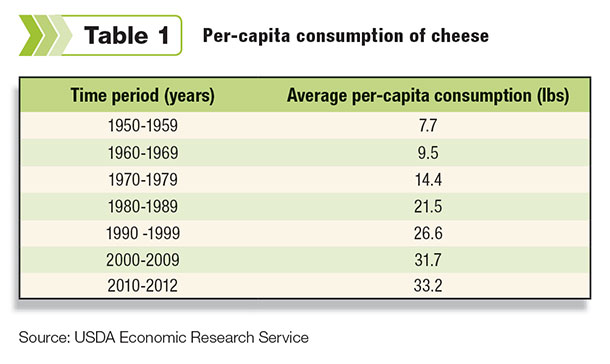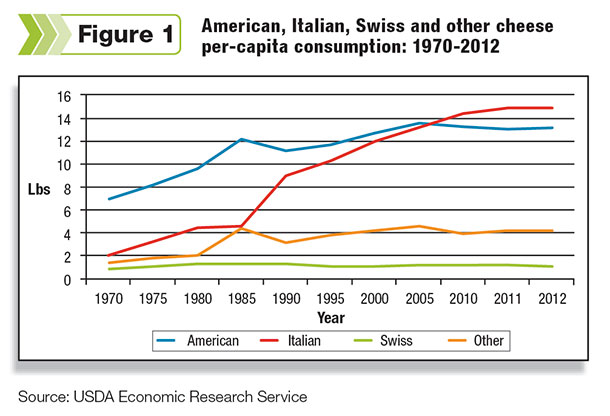Many significant things have occurred in the dairy industry during my lifetime. High on top of my list is the phenomenal increase in U.S. cheese consumption. In 1950, per-capita cheese consumption was 7.7 pounds. In 2012, the most recent data available, per-capita consumption of cheese was about 33.5 pounds. A person today, compared to 62 years ago, is eating 25 pounds more cheese per year.
Back in 1950, U.S. cheese makers only needed to manufacture about one billion pounds of cheese, utilizing 10 percent of the nation’s milk production to meet cheese demand. Last year about 11 billion pounds of cheese was manufactured in the U.S., which required more than one-half of the nation’s milk production.
With cheese utilizing the majority of dairy farmers’ milk production, it is important to review the significant increase in cheese consumption, reasons for the growth, changes in varieties of cheese consumed and what the future may hold for further increases in cheese consumption.
As seen in Table 1 , per-capita cheese consumption almost doubled from the 1950s to the 1970s. Then, in the 1980s, consumption increased almost 50 percent from the previous decade. Per-capita consumption added another 5 pounds in the 1990s and another 5 pounds from 2000 to 2009. So far in this decade, per-capita consumption has averaged over 33 pounds.

Cheese varieties
The varieties of cheese consumed have changed over time. See Figure 1 . In 1970, over 60 percent of the cheese consumed was American styles – cheddar, colby, Monterey Jack and stirred curd (used to make American cheese). Italian cheese was about 18 percent of total cheese production. Swiss was about 8 percent, and the other varieties (brick, Muenster, cream, blue and Hispanic) about 14 percent.

Since 1970, Italian cheese showed the largest consumption increase. Per-capita consumption grew slightly from over 2 pounds in 1970 to almost 15 pounds of Italian cheese in 2012. In 2006, per-capita consumption of Italian cheese exceeded American cheese and has remained above American cheese since.
Per-capita consumption of Swiss cheese remains around 1.2 pounds. The consumption of other cheese has remained fairly constant since the mid-1980s. For the past few years, per-capita consumption of American cheese has remained relatively flat, a little over 13 pounds.
Why people are eating more cheese
Let me share four primary reasons for increased cheese consumption. First on my list is the increase in meals eaten away from home compared to 30 or 40 years ago, plus the prepared meals purchased or brought home to eat.
Think of all the cheese used by fast food and casual dining restaurants. Consider all the pizza picked up or delivered to eat at home. Increased pizza consumption is the driving force behind per-capita consumption of Italian cheese going up over 600 percent from 1970 to 2012.
As I tell people, home delivery of fluid milk is a thing of the past for most consumers, but it was replaced by home delivery of milk in another form: pizza. Consumers today prefer “eating” their milk versus drinking it.
A convenient, tasteful, nutrient-dense form of nutrition is the second reason for higher consumption. Cheese is easy to eat; no cooking is required. Just cut off a piece or peel off a slice, and eat it. Today’s consumer wants food that is convenient with good nutrition and taste.
Cheese has it all. Hats off to today’s cheese industry for continuing to improve technology and procedures to manufacture a consistently high-quality cheese. Plus, the large number of varieties of cheese offer a wide range of tastes from sharp to mild to nutty to hot and spicy. Consumers like choice and variety.
The third reason is versatility. There is almost an unlimited number of ways cheese can be used. It can be eaten alone, used in cooking a variety of foods, shredded on salad or soup, used to transform a hamburger into a cheeseburger, part of many sandwiches or its own sandwich, or melted on nachos.
It is estimated about one-half of the cheese manufactured is used as an ingredient in other products versus eaten alone. Research and development into new uses for cheese continues. Thirty years ago, who would have thought a leading breakfast meal would be a slice of cheese with an egg and bacon piled on an English muffin?
My fourth reason is the consumer focus of the cheese industry. When I was growing up in the mountains of North Carolina, there were only three ways to buy cheese: Cut a chunk off a waxed hoop at the country store, wrapped up in a package of American slices or processed in the form of Velveeta, which came in a box.
Today the varieties and styles available for consumers are in the hundreds, and the number keeps growing. Besides all the varieties, the cheese industry has and continues to work to make cheese appealing and consumer-friendly as possible.
Go into most any retail grocery store and you can purchase cheese in a chunk, 8-ounce package, sliced, shredded, or the deli or cheese center will weigh out the amount you need. Cheese now comes in more easily opened and re-sealable packages. It is displayed in stores on peg boards so consumers can easily choose the variety they desire.
Cheese makers for the pizza industry have and continue to develop cheese with better melting properties, flavor and appearance to keep the consumer coming back for more pizza. The cheese industry understands it is the customer who keeps them in business and who will continue to keep them in business.
Future
Looking to the future, U.S. consumers will continue to eat more cheese. The same factors that are responsible for the phenomenal growth in cheese consumption will continue to drive cheese consumption in the future.
Add to those factors improving economies and household incomes, both in the U.S. and other countries, means higher cheese consumption as well. During the past 10 years, the annual increase in per-capita cheese consumption is about 1 percent. Let’s assume this continues for the next 16 years.
Then in 2030, per-capita cheese consumption would be close to 40 pounds. Forty pounds of cheese may seem high to some, but many European countries are well over that today, with the French consuming more than 50 pounds and the Greeks about 68 pounds.
When growth in U.S. population is added to higher per-capita consumption, it will require about 13 billion pounds of cheese to meet domestic demand in 2030. This is two billion more pounds of cheese than was manufactured in 2013 and will require an additional 20 billion pounds of milk to produce.
This projected increase does not take into account the growing exports of U.S. cheese. As the standard of living improves in developing counties, cheese demand will increase in those countries as well. U.S. cheese manufacturers will help meet this demand.
The bottom line is that cheese has and will continue to be a growing market, both domestically and internationally. Cheese provides convenience, nutrition, taste and variety – characteristics desired by consumers. For dairy farmers, cheese is and will continue to be the majority user of their milk production for the foreseeable future. PD
Calvin Covington is a retired dairy cooperative CEO and now does some farming, consulting, writing and public speaking.

Calvin Covington
Retired Dairy Co-op Executive





